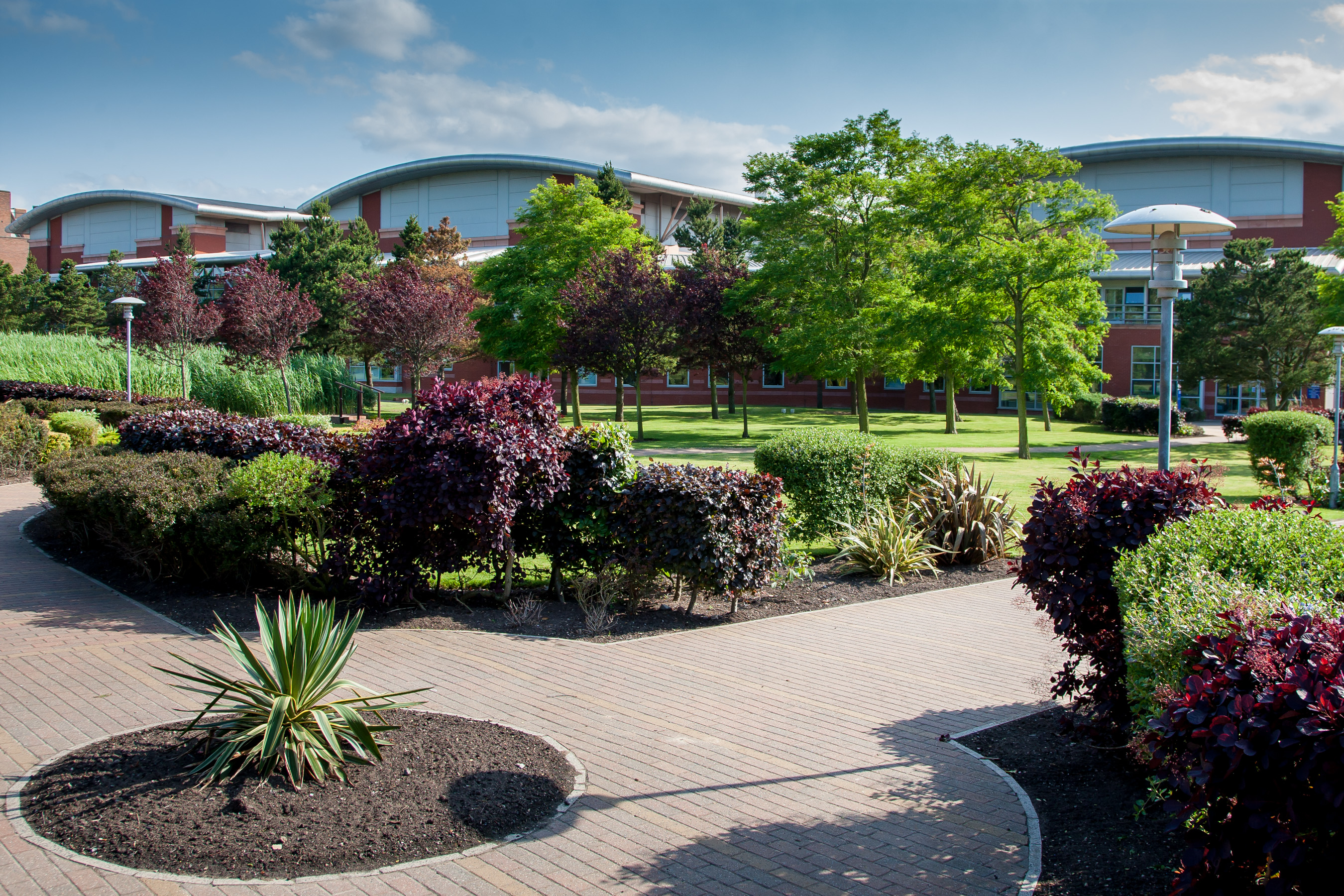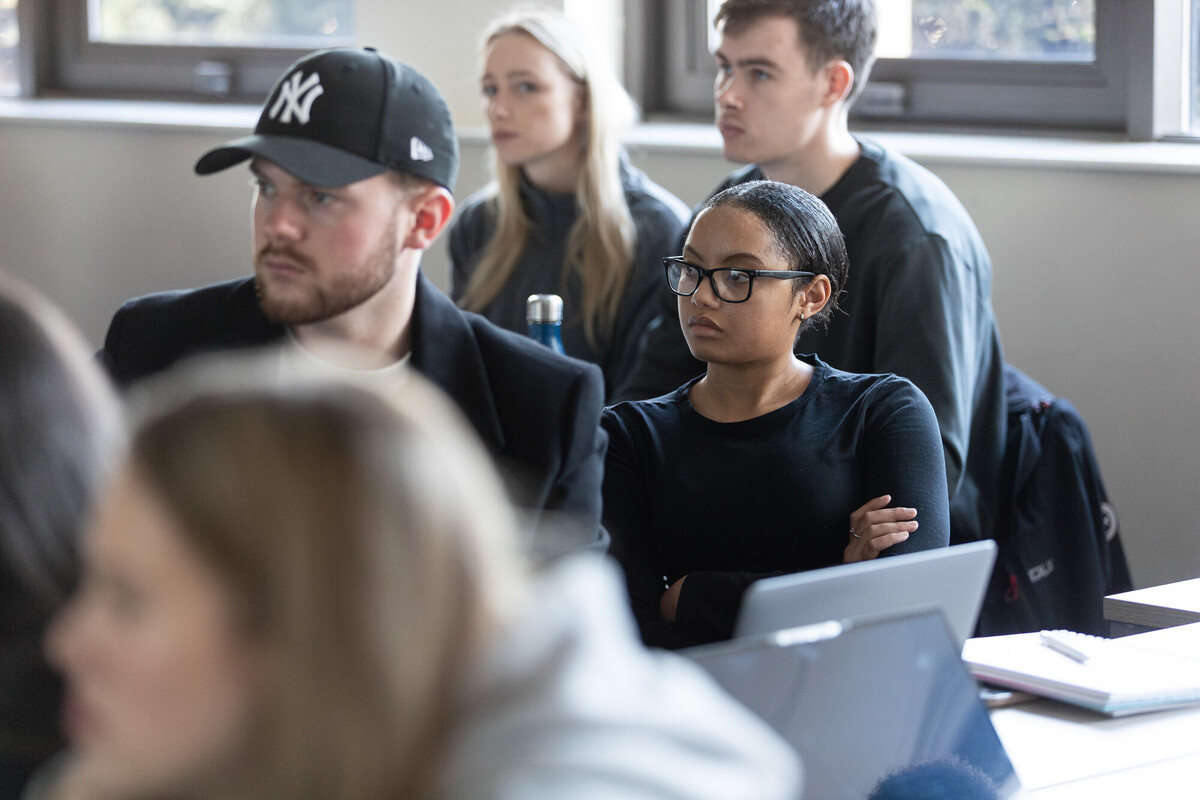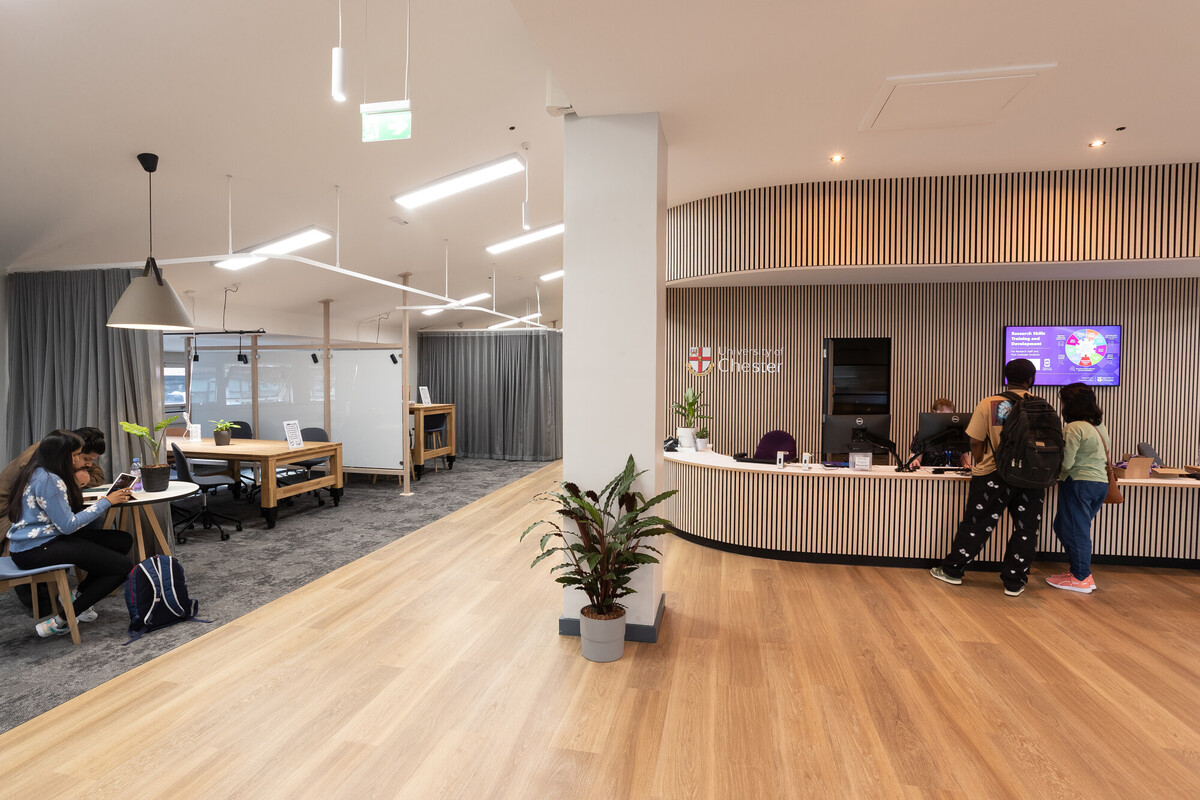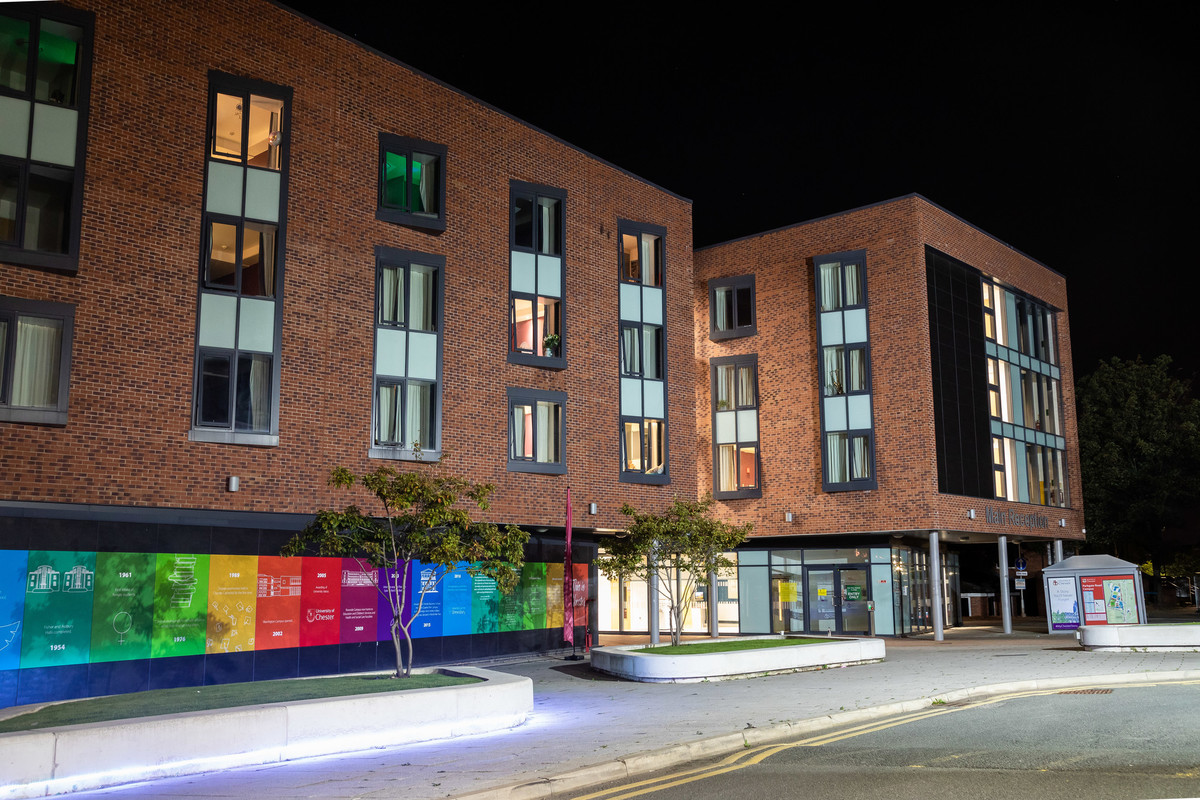Physics BSc (Hons)
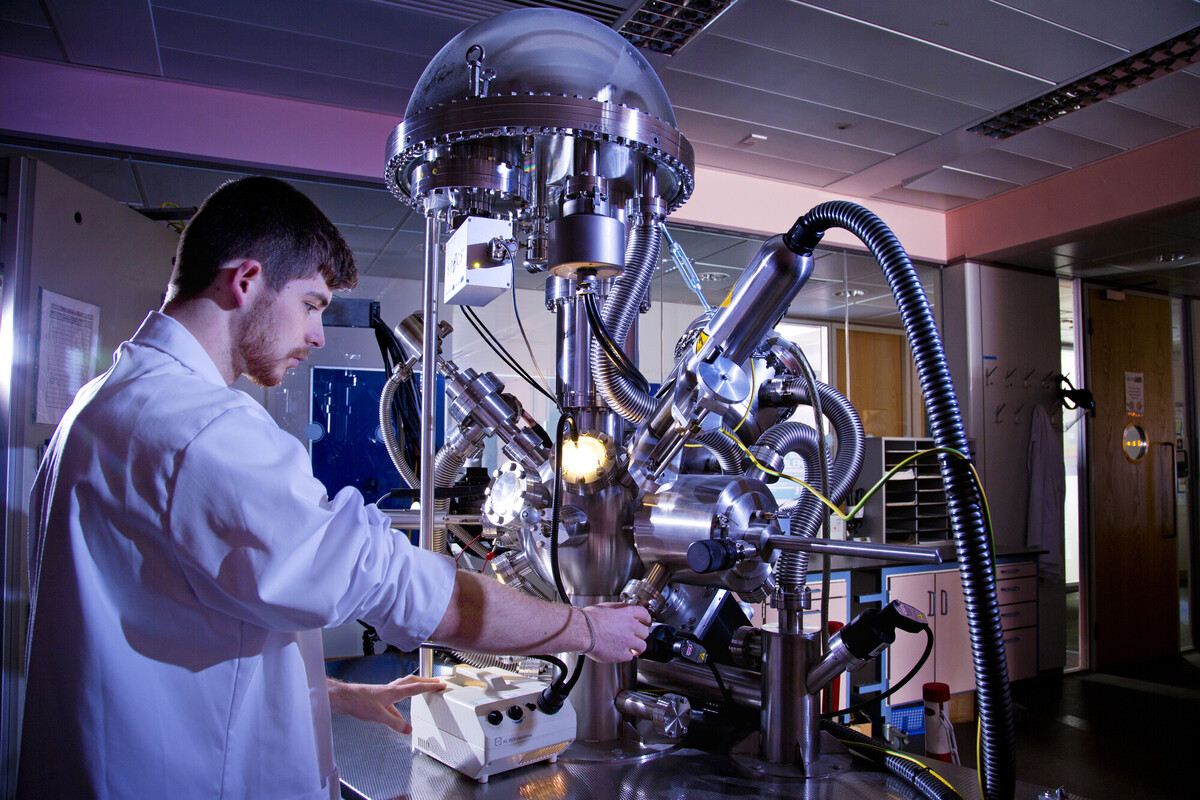

You are viewing Course summary
Course Summary
The course includes a wide range of research-informed modules, such as quantum mechanics, astrophysics, lasers, nuclear technology, artificial intelligence and more!
Our BSc Physics course prepares you for a challenging yet rewarding career in science. Industrial relevance and interdisciplinary collaboration are something we are passionate about in the School of Natural Sciences, as we are closely connected with 40 technology-oriented companies based in close vicinity of Thornton Science Park.
You are encouraged to work on industry-guided projects with our industrial partners or other companies in the UK or Europe via our Second Year Work Based Learning module. This module offers a five-week placement of 175 hours where you will gain practical skills that will prepare you for after graduation. Your final-year research project also has practical elements and is supervised by an academic member of staff or industrial partner, or both. In addition, the BSc Physics course is available with an optional placement year that can be taken between your second and third year of study.
A high proportion of your time will be spent in our modern laboratory facilities, equipped with industry-standard and research-quality instruments. You will acquire the necessary laboratory and practical skills to supplement your scientific and technical knowledge.
Enjoy a wide range of career options such as working in industrial and commercial companies, research institutes, central and local government, education, consulting, and even finance and the stock market.
What you'llStudy
In Year 1, you will cover the essential concepts of classical physics, such as optics, mechanics, electricity and thermodynamics, along with the study of basic mathematical methods.
Module content:
University Skills
- Working in teams: roles and responsibilities, record-keeping, survival skills, peer assessment
- Making and monitoring a plan
- Report writing: technical and laboratory reports, structure, content, grammar, the importance of accurate referencing and avoidance of plagiarism
- Effectively search a range of different information sources and critically evaluate for appropriateness for academic use. Understand the nature of research journal publishing and the importance of primary research findings to study of scientific/technology disciplines.
Professional Skills
- Introduction to professional ethics
- The role and responsibilities of the scientist and the engineer in society and in protecting the environment
- The inter-disciplinary nature of engineering.
- CV and cover letter writing
The Design Process
- The design process: introduction to the key stages of research, concept, feasibility, requirements, preliminary design, detail design, production.
Module aims:
The purpose of this module is to ease the transition from school to university by setting the multi-disciplinary context and expectations of degree courses and careers in engineering and natural sciences. Students will be introduced to design, which is the integrating theme that runs throughout engineering degrees, and has great relevance to scientists.
Students will be introduced to the transferable study skills that they will develop throughout their university career. In particular, they will develop their communication skills, team-working skills, and they will understand the need to take responsibility for their own learning.
Module content:
Mathematics
- Introductory review: arithmetic, algebra, notation
- Elementary Functions: relations, functions, standard functions, hyperbolic functions, limits
- Solving Equations: linear, quadratic, simultaneous, polynomial, inequalities
- Trigonometrical functions: identities, equations and engineering applications
- Complex Numbers: concept, arithmetic, De Moivre’s theorem, regions in the complex plane
- Matrices: matrix algebra, determinants, inverse, transformations, notation
- Ordinary Differentiation: techniques, maximum and minimum values, higher derivatives, applications
- Partial Differentiation: functions of two variables, partial differentiation, small increments and differentials
- Integration: techniques, standard integrals, integration by parts, partial fractions, trigonometric functions, analytical techniques, Simpson's rule, applications (e.g. area, mean value, centroids, RMS, volumes of revolution)
- Vectors: vector algebra, cartesian coordinates, scalar and vector product
- Linear Algebra: Gauss elimination, Gauss-Jordan method, iterative method
- Sequence and Series: infinite, convergent, divergent, Standard, Taylors, Mclaurins and Binomial series, approximate and limiting values
- Differential equations
Computer Workshops
- Selected areas of the syllabus will be taught at the computer. These sessions will explore the mathematical technique, rather than use of software, so fully guided examples based on engineering or natural science problems will be provided. Students will begin to identify the commonality of equations describing engineering systems.
Design
- Use of mathematics in establishing/evaluating solutions.
Module aims:
A good mathematical grounding is essential for all scientists and engineers. The mathematics in this syllabus provides the foundation for deeper analysis and understanding of scientific and engineering subjects, and enhances the student’s ability to make sound judgements regarding the science and technology that they will use in the course of their career. Wherever possible, mathematical theory is taught by considering a real example, to provide students with the context for the mathematical tools they will use. Solutions are considered by both analytical and numerical techniques. Where basic principles are involved, some proofs will also be taught.
Module content:
Principles of Circuit Theory and Electrical Engineering
- Basic definitions of current, voltage and power.
- Principles of electrical conduction; voltage and current sources, resistors, capacitors, and inductors.
- DC circuits: Ohm’s Law, Kirchhoff’s Laws, Norton and Thevenin equivalent circuits with voltage and current source transformations. Steady state and transient (switching) DC circuit analysis. Analysis by nodal and loop methods. Superposition Theorem. Power.
- AC Circuits: Sinusoidal signals, amplitude, frequency and phase. Complex notation, Ohm’s Law, Kirchhoff’s Law and Norton and Thevenin equivalent circuits generalised to impedance and admittance. Steady state AC circuit analysis and phasor diagrams. Frequency response for RC, RL and RLC circuits. Resonance for RLC circuits. Superposition Theorem and Single Phase AC power.
- Introduction to Sensors: Sensor Performance (Range, Resolution, Error, Accuracy, Uncertainty, Precision, Linearity, Sensitivity). Sensor Types (Light, Force, Displacement, Motion, Sound). Sensor interfacing
- Introduction to Actuators; Actuator Types (Heat, Light, Force, Displacement, Motion and Sound). Actuator Interfacing
- Measurement and Test Equipment: Meter Loading effects for voltage and current measurement. Use of multimeters, oscilloscopes, power supplies and signal generators in the laboratory.
Introductory Analogue Electronics
- Semiconductors: Semiconductor doping, electron and hole transport. The device physics of a p-n junction in forward and reverse bias.
- Diodes: diode equation, graphical/load line analysis, diode models. Zener and light emitting diodes. Diode circuits including rectifier, peak sample, power rectifier, clamps and regulator.
- Bipolar Junction Transistors (BJT): BJT structure, basic BJT operation, BJT characteristics and parameters, BJT amplifiers and BJT switching applications.
- Field effect transistors (FET): FET characteristics and parameters, FET biasing, FET amplifiers and FET switching applications.
- Operational amplifiers: Concept of an ideal operational amplifier and its practical realisation, design of inverting, non-inverting, summing and differential amplifiers.
Introductory Digital Electronics
- Number systems: decimal numbers, binary numbers, decimal-to-binary conversion, binary arithmetic, 2’s complements of binary numbers, hexadecimal numbers.
- Logic gates: the Inverter, AND, OR, NAND, NOR, Exclusive-OR and Exclusive-NOR.
- Logic fundamentals: Boolean algebra and logic simplification, Karnaugh map, De Morgan’s law.
- Combinational logic analysis: basic combinational logic circuits, implementing combinational logic, the universal property of NAND and NOR gates, combinational logic using NAND and NOR gates.
- Basic sequential logic circuits: Latches, S-R Flip-Flop, D Flip-Flop, J-K Flip Flop, registers.
Module aims:
An understanding of the basic principles and many of the important practical applications of electronic and electrical engineering is now essential to practitioners of other disciplines. The aim of the module is to provide a foundation in these topics, of sufficient depth to be useful, and without being over complicated or cluttered with too-rigorous and exhaustive mathematical treatment. Wherever possible, content is contextualised in the laboratory so that students can become familiar with instrumentation, measurement and simulation techniques relevant to electronic and electrical engineering. Students will also engage with the full hardware development life cycle via the design, simulate, build and test of selected simple circuits.
Module content:
The module content may include:
- Introduction to Materials in Engineering: metals, ceramics, polymers and composites
- Atomic structure, inter-atomic bonding and inter-atomic forces, the structure of solids, crystal imperfections, elastic and plastic deformation
- Diffusion in solids: diffusion fundamentals, diffusion mechanisms, processes using diffusion, diffusion modelling, diffusion and temperature
- Phase Diagrams: solubility limits and phases, binary phase diagrams and their interpretation, isomorphous diagrams, eutectic, peritectic and eutectoid reactions, development of microstructure, eutectic and dendritic microstructures
- Intermediate phases: effects of non-equilibrium cooling, industrially important binary diagrams, Fe-C system, development of steel microstructures, brasses and bronzes, solders, alumina-silica
- Phase transformations: types of transformation, transformation diagrams, transformation products
- Mechanical properties and methods of measurement: elastic deformation, plastic deformation, stress, strain, hardness, ductility, brittleness, resilience, toughness, creep, wear and fatigue
- Mechanical failure: failure mechanisms, design, cracking, temperature effects, fatigue, creep
- Materials in engineering applications: case studies (including materials impact on the environment).
Module aims:
Students will be introduced the fundamental properties of common engineering materials through an understanding of the atomic and molecular interactions within the material. More broadly, the module aims to give students an awareness of a wide range of materials and their applications.
Module content:
- Basic definitions; energy, working fluid, continuum, property, systems, surroundings, open and closed systems, phase, state, equilibrium, process, cycle.
- Zeroth Law of Thermodynamics: temperature scales.
- Perfect gases, ideal gas equation of state, real gases, compressibility factor, van der Waals equation of state, virial coefficients
- Work and heat definitions, path functions, types of work, sign conventions, definite integrals
- First Law of Thermodynamics
- Internal energy, enthalpy, constant specific heats, specific heat variation with temperature
- Polytropic processes
- Properties of pure substances; changes of state, sub cooled, saturation and superheated properties, use of tables, phase diagrams.
- First law analysis of systems, cyclic processes, closed systems, open systems (steady and unsteady flow), application to engineering equipment, internal combustion engines.
Module aims:
Thermodynamics is a basic science that deals with energy interactions in physical systems. The purpose of this section is to study the relationship between heat (thermos) and work (dynamics). A range of real-world applications are presented to give students a feel for scientific and engineering practice and an intuitive understanding of the subject matter.
Module content:
Geometrical Optics
- Principles.
- Simple optical systems.
Waves and Oscillations
- Free, damped forced & coupled oscillations, including resonance and normal modes.
- Waves in linear media: particle & group velocity.
- Vibrating strings.
- Sound waves.
- Doppler effect.
Wave Nature of Light
- Interference & diffraction at single and multiple apertures.
- Dispersion by prisms and diffraction gratings.
- Optical cavities and laser action.
Newtonian Gravitation
- Newton’s Law.
- Copernicus’ model of planetary motion.
- Kepler’s 1st, 2nd & 3rd law.
Special Relativity
- Michelson-Morley experiment.
- Principles of Relativity and Invariant Light Speed.
- Galilean & Lorentz transforms.
- Consequences, including energy-momentum relationship.
Background to Atomic and Quantum Physics
- Black body radiation.
- Photoelectric effect.
- Wave particle duality.
- Heisenberg’s uncertainty principle.
- Spectra of simple atoms, leading to quantum structure, quantum numbers, Pauli exclusion principle and atomic structure.
- Introduction to the Schrodinger Equation and the development of atomic orbitals
Essentials of Nuclear Physics
- Nuclear masses and binding energies
- Radioactive decay, fission and fusion
- Elementary particles, fundamental forces and the Standard Model
Module aims:
This module is wide-ranging and introduces the student to the fundamental concepts required to understand the physical world around them. They will be led through the essential elements of classical physics through to an appreciation of the quantum world of atomic structure.
Geometrical Optics
Students will develop knowledge and understanding of the function of the behaviour of optical components and how they may be combined into simple optical systems.
Waves Nature of Light
Students will understand the limitations of geometrical optics in describing the behaviour of optical systems; wave-particle duality will be introduced through the Young’s slit experiment.Students will further develop their understanding through investigation of dispersion, diffraction and laser effects.
Waves and Oscillations
Students will be introduced to the concepts and mathematical expression of wave phenomena including free, damped, forced and coupled oscillations. Group velocity will be introduced.Transverse and longitudinal wave phenomena in a range of media including strings and air are described.
Newtonian Gravitation
Students will understand Newton’s law of gravity and the Copernican model of planetary motion.They will further develop their understanding through investigation of Kepler’s laws.
Special Relativity
Students will be introduced to the concepts of relativity and the invariance of the speed of light through the example of the Michelson-Morley experiment. Students will develop an understanding of Newtonian and relativistic (Lorentz) transformations, and appreciate the consequences of the energy-momentum relationship.
Atomic and Quantum Physics
The breakdown of classical physics and the necessity for the introduction of quantum mechancis will be explored. Students will review the spectra of simple atoms and their interpretation in terms of quantum structure.
Essentials of Nuclear Physics
The basics of nuclear structure will be reviewed, along with radioactive decay, fission and fusion. The concepts of elementary particles, fundamental forces and the Standard Model will be introduced.
Module content:
This module will help you develop skills in a number of areas essential to success as a modern physics graduate. Programming and computational techniques are all pervasive in today's society, from the next generation of quantum-secure algorithms allowing secure communication with your bank, to using mathematical computer simulations to model real-world phenomena. Understanding mathematical arguments and communicating your own ideas clearly are key skills as a physicist. Classical mechanics is a core part of the physicist's toolkit, and provides the foundation for other advanced topics in physics.
The module is split into several different parts. We will provide an in-depth introduction to algorithms and the process of translating these into computer programs, using state-of-the-art software tools, such as Python. This will provide you with a solid foundational understanding to tackle any future computational and programming challenges. You will develop important research and writing skills. You will learn to use LaTeX, an industry-standard typesetting system for produce professional scientific documents. You will also learn the principles of classical mechanics and will apply your knowledge and skills in a wide range of scenarios, including the use of computational approaches, for example using Python.
- Comprehension and understanding of mathematical arguments.
- How to write coherent mathematical arguments.
- Introduction to mathematical and scientific typesetting with the LaTeX package and associated editors.
- Incorporating graphs, figures, tables and bibliographic information in reports and articles, using LaTeX
- Referencing methodologies in the Mathematical Sciences.
- Introduction to online search tools and searching the library catalogue.
- Introduce algorithms and how to translate them into computer programs.
- Introduce students to computer programming software, for example Python.
- Learn about basic programming concepts including algorithms, loops, conditional statements and functions. Also learn about more advanced scientific functions.
- Introduction to numerical algorithms from a variety of mathematical and scientific areas.
- Introduction to classical mechanics.
- Applications of classical mechanics to a wide range of physics scenarios, for example particle collisions and the flow of fluids.
- Exploration of the use of computational modelling in classical mechanics.
Module aims:
- Equip students with the necessary technical skills to facilitate communicating Mathematics to both specialist and more general audiences.
- Develop students' skills and confidence in communicating their scientific ideas and outputs both verbally and in writing.
- Introduce students to programming and translating algorithms into computer code.
- Introduce students to the concept of independent learning through research skills and tools.
- Introduce students to the principles of classical mechanics and develop students' skills in solving mechanics problems, including the use of computational approaches.
In Year 2, topics include quantum mechanics, solid state physics, electromagnetism, statistical physics, advanced materials characterisation and further mathematical methods and modelling. You will also take a work-based module.
Module content:
Mathematics and Modelling
- Statistical methods; distribution, sampling, statistical inference, estimation from a sample, hypothesis testing, significance testing.
- Matrix Eigen value problems, with application to solutions of Ordinary Differential Equations.
- Laplace transforms for solution of Ordinary Differential Equations.
- Fourier series approximation of periodic functions.
- Solution techniques for partial differential equations including the heat equation.
Numerical Modelling and Computation
- Construction of algorithms in high-level programming languages including, variables, arrays, operators and expressions, data input and output, flow control and functions.
- Implementation of numerical methods using MATLAB.
- Numerical solution of ordinary differential evolution equations using Euler's method and the Runge-Kutta methods.
- Introduction to Optimization; Optimisation of functions of several variables, with and without constraints.
- Representation of engineering problems as mathematical optimisation problems and solution using Excel Solver.
Module aims:
The purpose of this programme of mathematical study is to ensure that students are competent in calculations using a range of mathematical tools. The content will extend the student’s analytical skills by introducing more advanced topics that are required parts of the modern engineers skill set, and enhance their ability and confidence to make sound judgements.
Module content:
Electromagnetics
- Electrostatics: Review of basic concepts; charge, potential, electrostatic energy, force, effects of dielectric materials.
- Magnetostatics: current sources of magnetic fields, magnetic field strength, magnetic flux density, magnetic materials, BH curves, saturation.
- Interface conditions, magnetic field energy, forces.
- Coulomb, Gauss and Ampere’s Laws.
- Simple magnetic circuits.
- Time varying current and fields in conductors; Faraday’s Law.
- Lenz and Lorentz laws.
- Electromagnetic Devices: Basic action of transformers, motors and actuators.
Electromagnetic Waves
- The electromagnetic spectrum.
- Maxwell’s equations and the plane electromagnetic wave solution.
- Energy density of an electromagentic field.
- Poynting vector.
- Polarisation.
- Plane waves in an unbounded medium.
- Reflection and transmission of waves.
Module aims:
The purpose of this module is to deepen students’ knowledge of electromagnetics through investigation of the theory of electromagnetic fields and waves, and the behaviour of different types of generic signals within relevant electrical circuits. At the end of this module, students should be able to
(i) construct mathematical models of signals and systems and apply these models to predict the response of a linear system to a specified stimulus,
(ii) understand the wave nature of electromagnetic fields, the significance of Maxwell’s equations, and the propagation of waves across plane boundaries.
Module content:
Schrödinger Wave Equation
- Wave function and its interpretation
- Standard solutions including the hydrogen atom
- Tunnelling
- Time-independent Perturbation Theory
Electron Theory of Solids
- Overlap of atomic orbitals – formation of energy bands
- Brillouin zones
- Density of states
- Conduction and valence bands, modifications at surfaces and interfaces
- Perturbation theory
- Electron spectroscopy
Thermal Properties of Matter
- Phonons and lattice vibrations
- Heat capacity
Semiconductors and Doping
- Semiconductor properties
- Doping
- Electron-hole pairs
- Device fundamentals
Magnetic Properties of Matter
- Ferromagnetism, paramagnetism and diamagnetism
- Electron dipole moment
- Lorentz force and classical diamagnetism
- Curie temperature, domains
- Magnetic materials
Module aims:
This module builds on the material introduced in module SE4024 Classical and Quantum Physics at level 4, extending it such that students gain knowledge and critical understanding of the role of the electron theory of solids in predicting materials phenomena.
Schrödinger Wave Equation
Students will explore the concept of the wave function and its interpretation in quantum mechanics.The role of the Schrödinger equation as the quantum mechanical analogue of Newton’s laws of motion and the conservation of energy will be presented; standard solutions will be described. Students will obtain an appreciation of the phenomenon of tunnelling.
Electron Theory of Solids
Students will extend their knowledge of the concept of overlapping atomic orbitals and the formation of electron energy bands in condensed matter. The role of symmetry as in the concept of the Brillouin zone will be discussed. Students will explore how differences in band structure and the density of electron states govern the electronic properties of materials.
Phonons and Heat Capacity
Students will gain knowledge of the role of lattice vibrations in heat conduction and heat capacity.
Semiconductors and Doping
Students will gain knowledge and understanding of how the electron theory of conducting solids can be extended to semiconducting materials, and how the properties of semiconductors can be affected by the nature and level of dopants. The main concepts of semiconductor device operation will be covered to include properties of diodes and transistors.
Magnetic Properties of Matter
Students will develop an understanding of how magnetic properties derive from electronic structure, and how the main classes of magnetic materials arise.
Module content:
- Second Law: treatment of reversible and irreversible processes, corollaries of second law, definitions of entropy and isentropic processes
- Mass and Energy Transfer:Extension of principles to non-steady-state and reacting systems
- Combustion: Thermodynamics of reacting systems. Definition of standard states. First law analysis of reacting systems including dissociation. Use of combustion tables, solution of various types of combustion problems
- Cycles: Different types of engineering cycles. Methods of improving cycle efficiency
- Energy Use: Theoretical limits on energy efficiency. Sources and sinks and implications for environment. Opportunities for and implications of energy efficiency.
- Chemical thermodynamics - equations of state and phase equilibria for pure fluids, phase equilibria in fluid mixtures, reaction equilibria
Module aims:
Thermodynamics is the science that deals with energy interactions in physical systems. The purpose of this module is to extend the basic principles heat, work and energy then apply this knowledge to real engineering problems, and also to introduce chemical thermodynamics - the interaction of heat and work with changes of state and chemical reaction.
Module content:
Microscopy
- Optical Microscopy, including image formation, contrast techniques (bright/dark field, phase & interference contrast), fluorescence techniques. Digital image acquisition.
- Electron Microscopy: Scanning electron microscopy secondary & backscattered electron image formation. Transmission electron microscopy bright/dark field & STEM modes. Electron diffraction in the TEM.
Characterisation of Solids
- X-ray analysis in electron microscopy (SEM-EDX)
- X-ray diffraction, including crystal lattice & lattice systems; Miller Indices, planes & directions; point and space groups; X-ray scattering, Braggs Law, reciprocal space; powder diffraction.
- Introduction to surface techniques.
On-line and at-line techniques
- Introduction to the concept of on-line and at-line measurements for process control in industrial plant.
- NIR and Chemometrics.
Module aims:
Microscopy is fundamental to our understanding of the structure and behaviour of physical and biological systems and as such is an essential tool for the Natural Scientist. The principle techniques of optical microscopy are studied and comapred for different applications and specimen types, with their advantages and limitations reviewed. This is extended to electron microscopy (SEM and TEM) where the concept of analysis in-situ in the microscope is introduced. The recently-developed scanned probe techniques of AFM and STM are also covered.
Solids characterisation presents many challenges that are not present in liquids and cannot be tackled by conventioanl analytical chemistry methods. The concept of a solid as a mixed multi-phase material is introduced and methods for characterisation on the micro- and nano-scale are explored. The analysis of crystalline solids by X-ray diffraction is developed, and principle crystal systems and the concept of the reciprocal lattice are covered. Surface-specific methods are also introduced and critically reviewed.
An introduction to automated and on- or at-line techniques is included, leading to the concept of proxy measurements and the use of chemometrics.
Module content:
The traditional academic programme structure is not applicable in this experiential learning internship opportunity. The placement content is freely structured and subject to negotiation between the student, the host organisation and the placement supervisor.
A mid placement conference will be used for a mid term assessment and facilitate the student's transition between the placement year and their return to University for their final year. The conference will enable students to share experiences and analyse the range of skills derived from the placement. It will also further develop the construction of their learning logs and portfolio and give opportunities to plan ahead for their final year projects/dissertations.
Module aims:
To provide students with an opportunity for first hand work experience in an industrial setting and to experience a broad range of tasks and responsibilities in different professional areas.
To allow students to apply and enrich their previous theoretical knowledge and understanding of course content through observation and application to tasks, problems and scenarios presented in an industrial environment.
To enable students to recognise the nature of tasks, workloads, management problems and working methods in the working environment.
To enable students identify their personal interests in a working environment and develop their own personal development.
Module content:
The module will give an introduction to the physical aspects of a range of commonly used spectroscopy techniques:
- IR and Raman spectroscopy, molecular vibrations and selection rules
- UV/vis and luminescence spectroscopy, electronic transitions and Jablonski diagrams
- Time resolved spectroscopy techniques, Forster Energy and electron transfer
- NMR and ESR spectroscopy
Practical examples will be discussed to illustrate the application range and limitations of the spectroscopy techniques.
Module aims:
This module aims to provide knowledge and critical understanding of the key concepts associated with spectroscopy, concentrating on a series of techniques that are frequently used as analytical tools in a wide range of areas, in research and industrial applications.
During the course of study students will be supported and encouraged to discuss practical examples of how spectroscopy is used to solve real life problems in a series of settings. The focus will be on the recognition of the scope and limitations of each methods, and how different methods complement each other in their information content.
The practical part will extend the students competence in the application of experimental techniques in connection with the underlying theoretical concepts, and enhance their understanding of more particular subjects of study. It will also train the students in critical data analysis and the planning and designing of experiments.
Module content:
- Review of essential statistics, distributions, and probability theory
- Distinguishable vs indistinguishable particles
- Maxwell-Boltzmann statistics
- Fermi-Dirac and Bose-Einstein statistics
- Langrange multipliers and equilibrium particle distribution
- Dilute limit and partition function
- Statistical basis of internal energy, entropy, and pressure
- Mean free path and Van der Waals equation of state
- Statistical ensembles: micro-canonical, canonical, grand-canonical
Module aims:
The purpose of this module is to extend the knowledge of the basic principles of heat, work and energy via exploring the statistical mechanics approach to thermodynamics, creating a link between classical thermodynamics and the nanoscopic properties of matter.
Module content:
Pre-placement:
- Structured approaches to researching, selecting and securing a suitable work placement relevant to the student’s interests and career aspirations*.
- Writing an effective CV. Constructing a letter of application.*
- Interview skills.*
*Note: Students are required to undertake these pre-placement tasks during term 1 level 5, as part of the placement acquisition process and will be supported by the Work Based Learning team and the Careers and Employability department.
Induction Programme and Placement:
- The organisational context: research-informed analysis of the placement organisation’s aims, structure, culture.
- Self- assessment of needs: identification of the range of transferable skills, competencies and attitudes employees need and employers expect graduates to possess. (Employability Skills: e.g. verbal and written communication, analytical / problem solving capabilities; self-management; team working behaviours; negotiation skills; influencing people; positive attitude, resilience, building rapport).
- Devising a strategy for integrating into the workplace and work based teams
- Completion of online assignment tasks covering sourcing and obtaining placement; health and safety procedures in general; general workplace integrity; placement requirements.
During and post-placement: Learning effectively in and from the workplace:-
- Devising and implementing strategies to improve own approach and performance
- Critical analysis/evaluation of approach to skill development and performance in the workplace;
- Influencing the Placement Provider’s appraisal;
- Devising an action plan to develop gaps in transferable skills based on the placement experiences;
Module aims:
This module aims to enhance students’ prospects of gaining graduate level employment through engagement with a University approved work placement**, which will enable them to:
- Develop their understanding of workplace practice and lifelong learning;
- Enhance their work readiness and employability prospects through development of transferable skills;
- Take responsibility for their own learning and acquisition of workplace employability skills;
- Articulate, in writing, their employability skills.
In Year 3, you undertake a research project based in theoretical/computational or experimental physics. You will also choose from a range of topics in modules designed to provide deeper insights into physical science, such as astrophysics, nuclear technology, lasers, renewable energy, climate change, nanotechnology, artificial intelligence, nanoscale modelling, and more.
Module content:
- Evaluation of the principles of automated intelligence.
- Scientific and Engineering goals of intelligent technologies.
- Approaches to the development of intelligent software.
- Application domains for intelligent technologies.
Module aims:
- To introduce the concept of artificial intelligence (AI) and to evaluate its role in the development of advanced software systems.
- To introduce theoretical approaches to the development of intelligent software.
- To undertake practical tasks to demonstrate how AI techniques can be implemented.
- To analyse methods for designing and deploying intelligent technologies.
- To critically evaluate the ways in which intelligent technologies can be used in various domains: e.g. business, medical, educational, legal, government and scientific.
Module content:
Term 1: In the first term the module is underpinned by specialist lectures and seminar sessions, which explore the mechanisms and potential impacts of climate, change over long and short time scales. The initial focus is on - past climate change, sea level change and natural climate change processes and planetary controls. The module then progresses to exploring drivers of climate change and reviewing glacial and periglacial processes with particular reference to the British landscape.
Term 2: The module focuses on developing a sound appreciation of field and laboratory techniques used to advance scientific understanding of the recent record of climate change and future projections. Students gain first hand experience of initiating, planning and undertaking laboratory and field based investigations of a late Devensian and/or Holocene field site(s) with a view to reconstructing, in part, the environmental history. This is underpinned by specialist lectures and seminar sessions, laboratory sessions and fieldwork related to: Holocene chronology, fieldwork sample collection and preparation, biogeography, soils, geomorphology, stratigraphy and sedimentology.
Module aims:
1. To gain a well rounded appreciation of the controls and mechanisms of climate change in the context of past and future environmental change;
2. To explore the application of geographical knowledge, skills and techniques to evaluate climate change;
3. To make practical use of different approaches to investigate the terrestrial record of climate change in the UK;
4. To promote field and laboratory application of sedimentological, biogeographical, geomorphological and/or stratigraphical techniques used in environmental reconstruction
Module content:
Vector calculus and partial differential equations are indispensable tools in science. These topics are essential to our understanding of electromagnetism and quantum mechanics in physics, and are they are essential to the modelling of physical phenomenon such that fluid flow and heat conduction. This course is divided into two halves. The first half will cover topics related to three-dimensional geometry and vector calculus including: vector-valued functions, parametrised curves, line integrals and conservative vector fields, multiple integrals, surface integrals, the theorems of Green and Stokes, and the Divergence Theorem. The second half focusses on the theory of and techniques for solving partial differential equations. Topics covered will include: first order PDEs, classification and techniques for solving linear second order PDEs, Fourier series, the method of separation of variables applied to the heat, wave and Laplace equations, and Fourier transforms.
Module aims:
- Introduce students to the ideas and concepts of applied multivariate calculus, through vector and tensor-based approaches.
- Develop skills in solving problems involving curves, surfaces and volumes.
- Develop analytic techniques for solving a variety of partial differential equations.
- Introduce students to the underlying theory of some of the practical techniques developed.
Module content:
Students are free to choose any area of study that is related to their degree programme, provided that the department is able to supervise and resource the project. As such, the specific content of each project will vary, but in general an honours level project will be designed to facilitate testing of a hypothesis by experimental, observational, computational or theoretical means and will include such activities as planning, project management, information retrieval, equipment or software design and testing, the generation and evaluation of data, reporting and presentation of the results and conclusions Students are expected to conduct their work in a simulated professional environment and so industry based projects are encouraged. Academic staff will also suggest possible areas of study.
The project choices will be finalised at the beginning of the academic year. The final choices are subject to approval by the department who will make an assessment of the suitability of the project with respect to its content and deliverables. Regular meetings with the project supervisor throughout the project will ensure that students are able to develop their understanding of the relevant ideas in their chosen subject area.
Projects will typically include: a clear statement of objectives and deliverables; evidence of project planning and time/resource management; a survey of relevant published literature; design/manufacture/assembly of equipment; appropriate experiments, use of software or simulation; analysis and discussion of results; conclusions relative to the agreed objectives, and identification of further work. The analysis will also include a health, safety and ethical assessment and an evaluation of the environmental impacts of the activity.
The assessment methods for this module will allow the students the opportunity to demonstrate their ability to communicate complex technical information in a clear and unambiguous form.
Module aims:
The individual project provides students with a learning experience that will enable them to integrate many of the subjects they have studied throughout their degree. Students are expected to plan, research and execute their task while developing skills in independent thought, independent work and scientific competence. Students will also gain experience in presenting and reporting a major piece of scientific work, of immediate value, at a level appropriate for an honours degree student.
Module content:
Review of Nuclear Essentials
- Nuclear masses and binding energies
- Radioactive decay, fission and fusion
Radiation Safety
- Health aspects, dosimetry, detectors.
Sources of Radionuclides
- Nuclear reactors (Chalk River, Petten), Particle Accelerators (cyclotron), natural decay processes.
Particle Beams
- Scattering.
- Penetration, stopping power, binary collision approximation, SRIM, molecular dynamics.
- Particle beam techniques – MEIS, RBS, PIXE, Accelerator Mass Spectrometry, neutron scattering.
Radiation Applications
- Thickness monitoring.
- Sterilisation and food preservation.
- Neutron activation analysis.
- Radiotracer experiments.
- Medical applications – PET & other imaging methods, radionuclide therapy.
Nuclear Energy Sources
- Nuclear Fission; Uranium cycle, power station principles, moderation, waste, reprocessing.
- Breeder reactors.
- Thorium cycle.
- Nuclear fusion: toroidal confinement, laser and other experimental confinements, future directions.
Nuclear Technology Regulation
- Nuclear non-proliferation treaty.
- International Atomic Energy Agency.
- UK, EU and US regulatory bodies.
Module aims:
This module aims to provide knowledge and critical understanding of the science behind nuclear technology, including nuclear energy and particle beam technologies.
The initial focus is on radiation safety, and the origin and sources of radioactive substances.
The module presents the underlying principles behind key nuclear decay pathways and shows how energy may be extracted, with consideration given to the associate practical aspects of radiation safety and waste disposal.
Alternative applications of nuclear technology beneficial to mankind are discussed, including medical and industrial applications, and the use of nuclear particle beams for materials analysis and radiotherapy.
Students will be encouraged to discuss and critically evaluate the benefits and risks associated with the exploitation of nuclear technology within the context of population growth and increasing energy demand.
Module content:
Sustainability in Process Design
- The concept of sustainability. Environmental, economic and social criteria. The life cycle approach.
- Process design for sustainability.
- Specific industrial process examples.
Energy from Biomass
- Biomass types and characteristics
- Direct use
- Combustion based processes
- Vegetable oils
- Thermal conversion
- Gasification based processes
- Pyrolysis based processes
- Biological conversion
- Fermentation-based processes
- Anaerobic digestion based processes
- Chemical conversion
- Transesterification to biodiesel
Other Renewables and Associated Low Carbon Technologies
- Solar energy systems
- Solar thermal
- PV
- Wind energy systems
- Water energy systems
- Hydroelectric
- Wave
- Tidal
- Geothermal power generation
- Electrochemical energy conversion and storage
- Fuel Cells
- Batteries
- Other energy storage options
- The Smart Grid
Module aims:
The aim of this module to instil in students the regulatory requirements and technical considerations for designing, operating and decommissioning sustainable industrial chemical processes, and in particular sustainable energy generation systems.
The benefits of embedding Sustainability in Process Design in order to minimise the consumption of scarce material and energy resources is illustrated through the consideration of specific industrial process examples.
Thermal conversion and microbial degradation processes to derive Energy from Biomass is also presented in this module, reinforcing the application of biochemical fundamentals gained at earlier levels. A detailed overview is given of the current and future technologies for deriving power, heat and transportation fuels from biological sources.
Other Renewables and Low Carbon Technologies aims to give an insight into the other main sustainable power technologies. The teaching will draw on physical and engineering principles learned earlier, and will enable participants to critically assess the relative merits and applicabilities of these technologies.
Module content:
Background to laser design and operation
Principles of lasers
Laser construction concepts
Types of lasers
Fundamentals of laser material processing
Electromagnetic radiation
Reflection or absorption
Refraction
Interference
Diffraction
Laser beam characteristics
Focusing with a single lens
Optical components
Processes and novel laser applications for materials
Laser cutting and drilling
Laser welding
Laser surface treatment
Rapid prototyping and low-volume manufacturing
Laser ablative processes, macro- and micromachining
Laser cleaning
Biomedical laser processes
Laser automation and in-process control
Modelling
Mathematical theory
Simulation
Laser Safety
General safety concerns
Laser classification
Electrical and fume hazards
Module aims:
Background to laser design and operation/ Fundamentals of laser material processing
An understanding of the theory, principles and techniques used in Laser-materials processing (LMP) are required before more advanced understanding can be achieved. This includes knowledge of the stimulated emission phenomenon, techniques used to generate laser light, laser delivery methods and a detailed understanding of optics, including thin lens theory and the ability to identify the range of optics needed for laser beam transmission and manipulation.
Processes and novel laser applications
Students will understand the importance of wavelength in laser interactions with materials; industrial processes will be classified by wavelength and detailed description of each process including modelling techniques will be covered. These principles will be reinforced by independent projects undertaken by the students.
Students will learn to identify and describe the potential benefits to manufacturing processes offered by the application of lasers as a result of their unique characteristics. This knowledge requires advanced application of the multidisciplinary content of a mechanical engineering degree in areas such as materials science, dynamics, thermodynamics, fluid dynamics and electronics.
Modelling
Students will learn to apply mathematical models to predict future process outcomes on the basis of the present understanding.
Laser Safety
Students will be instructed in the principles of safe use of laser sources; covering the risk classification system, the relevance of wavelength, prevention and mitigation techniques as well as a wide range of associated considerations.
Module content:
Introduction to Methods and Quantities Involved in the Study of Stars
- Basic description and facts about the Sun, our solar system, our galaxy
(Milky Way) and the extragalactic environment at different scales. - Methods of observation and collection of data in astronomy (astrometry, photometry and spectroscopy)
- The link between observations and the physical and chemical properties of stars (position, distance, proper motion, luminosity, mass, size, temperature, spectral classes and composition)
- Classification of stars and the Hertzsprung–Russell diagram (the main classes according to stellar evolution and various types of variable stars)
The Formation and Evolution of Stars
- Description of gravitational contraction, hydrostatic equilibrium, energy transport and the different stages of nucleosynthesis via nuclear fusions occurring during the four phases of stellar evolution
- The interstellar medium and star formation
- The main sequence life of stars
- The post main sequence lifetime of stars (giants and supergiants)
- The “death” of stars and stellar remnants (white dwarfs, neutron stars and black holes)
The Discovery and Study of Planets beyond our Solar System
- A closer look on our solar system
- The discovery of exoplanets by the transit method
- A statistical view of the population of exoplanets
- Transmission spectroscopy (spectral signatures of exoplanetary atmospheres)
- Observational variations and orbital dynamics
Module aims:
This module aims to provide knowledge and critical understanding of the science associated with astrophysics, concentrating on the study of stellar objects and the discovery of planetary systems.
The content is designed to introduce the main principles and methods of work in observational and theoretical astronomy, which should enhance the understanding of more particular subjects of study.
The second part of the module presents the relevant physics and mathematical applications in the study of the evolutionary path of individual stellar objects from formation to the final stages and possible endpoints.
The final part of the module presents the observational techniques in the search for planetary systems beyond our solar system, the available data that we have at present and their interpretation.
During the course of study students will be supported and encouraged to discuss new ideas and synthesise information in order to apply their knowledge in the exploration of particular areas of study, e.g. super-massive stars, supernovae and black holes.
Module content:
Control
- Introduction
- Modelling systems
- Differential equations
- Eigen values and system response
- Linearisation
- Introduction to modelling and simulation for control systems design
- Perturbation model and initial conditions
- Laplace transforms
- Characteristics of Laplace transforms
- Combining transfer function blocks
- Open loop & closed loop
- Main parts of feedback control systems
- Effects of feedback
- Feedback characteristics
- Control system test inputs
- 1st order system response and characteristics
- 2nd order system response and characteristics
- Concept of Controller design
- PID Characteristics
- PID Anti windup
- PID controller structures
- Higher order stability using RH criterion
- RH criterion special cases
- Controller design using RH criterion (stability vs gain)
- Final Value Theorem and Setpoint tracking
- Disturbance rejection
- Multiple input transfer functions
- PID tuning for 1st and 2nd order systems with ZN and RH criterion
- Brief Introduction to practical control implementation
- Introduction to ITEA performance criterion
Simulation
Computer workshops will be provided for hands-on experience in designing control systems using the MATLAB/SIMULINK software package. Essential features of the control syllabus will be demonstrated through a collection of example problems.
Laboratories
Students will undertake a set of engineering control laboratories. The applications covered include:
- Mechatronic sensors
- Temperature control of a heating, ventilation and air conditioning (HVAC) system
- Speed and position control of a DC motor
Module aims:
Students will be introduced to control in relation to engineering systems, and in particular to develop methods of modelling the control of systems and processes. Techniques are explored with particular reference to common practical engineering problems and their solutions. The aim is to provide a sound underpinning of engineering control theory, which the students will then go on to develop in future years in their disciplines.
Module content:
Introduction
Review of quantum mechanics
Review of solid state physics
Mathematical modelling and the scientific method
Unix and high performance computing (hands-on)
Electronic Structure Methods
The many-body problem
Plane waves, pseudopotentials, tight-binding, and k.p method
Complex band structure and surface states within the tight binding model (hands-on)
Density functional theory
The Hartree-Fock approximation
Quantum Monte Carlo: variational Monte Carlo and diffusion Monte Carlo
Electron transport
Scattering theory and Green functions
Landauer-Buttiker formalism
Applications
Band structure and density of states of materials in the bulk using VASP (hands-on)
Work function of surfaces and adsorption energy using VASP (hands-on)
Conductance of a molecular junction using QuantumATK (hands-on)
Jellium and the local density approximation from CASINO (hands-on)
Molecular and chemical properties using CASINO (hands-on)
Module aims:
This module aims to (i) provide a broad understanding of electronic structure modelling in nanoscience and its relevance to device applications and nanotechnology, and (ii) instigate an appreciation of the importance of computational modelling in modern science and technology. The main objectives are as follows:
- Build on the basics of quantum mechanics, solid state physics, mathematical modelling, and high-performance computing to introduce students to the main scientific concepts of electronic structure modelling in a smooth and coherent manner.
- Present a variety of electronic structure methods that are widely used in high-tech industry to predict properties relevant to scientific areas such as nanoelectronics, photovoltaics, low-dimensional systems, catalysis, and surface science.
- Provide hands-on experience with a combination or research-standard computational packages, such as MATLAB, VASP, QuantumATK, and CASINO.
- Encourage students to critically evaluate the validity and accuracy of electronic structure models associated with specific technologies, in relation to experimental observation.
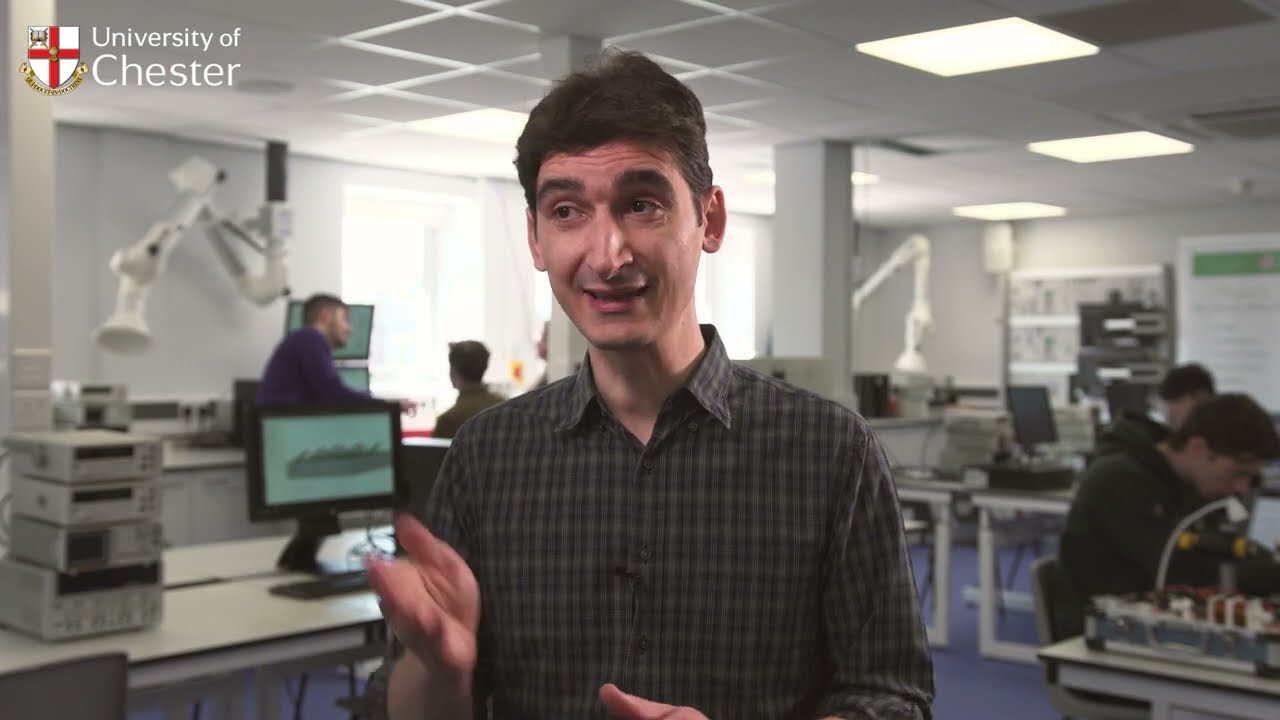
Physics at the University of Chester
Laboratory classes form an integral part of the learning environment and are key to the structure of the course. Assessment is by examination and coursework, including laboratory reports and an extended research project dissertation in Year 3. Tutorial sessions provide problem-solving experience and are informally assessed in class.
Beyond the Classroom
On this course, you have the opportunity to spend five weeks working for a host organisation via our innovative Work Based Learning module. You’ll have the chance to test-drive a future career, boost your CV and gain real work experience.
If you choose a degree with a Placement Year, you’ll have the opportunity to undertake a paid professional placement for a year. The year in placement allows you to experience the workplace, apply your learning and build connections for your future.
You are also encouraged to participate in student-led seminars, scientific field trips, career and networking workshops, or events organised by our STEM society. Students expand their educational path with a degree that goes beyond textbooks, fostering a holistic understanding of physics through exciting extracurricular activities.
Entry Requirements
112 UCAS points
|
UCAS Tariff |
112 points |
|
GCE A Level
|
Typical offer – BCC-BBC Must include A Level Physics |
|
BTEC |
Considered alongside A Level Physics |
|
International Baccalaureate |
26 points, including 5 in HL Physics |
|
Irish / Scottish Highers |
Irish Highers - H3 H3 H3 H3 H4, including H3 in Physics Scottish Highers – BBBB, including Physics |
|
Access requirements |
Access to HE Diploma (Science), to include 45 credits at level 3, of which 30 must be at Merit or above (including 15 at Merit in Physics) |
|
T Level |
T Level will be considered alongside A Level Physics |
|
OCR Cambridge Technicals |
Considered alongside A Level Physics |
|
Extra Information |
Welsh Baccalaureate Advanced and A level General Studies will be recognised in our offer. We will also consider a combination of A Levels and BTECs/OCRs. |
Students from countries outside the UK are expected to have entry qualifications roughly equivalent to UK A Level for undergraduate study and British Bachelor's degree (or equivalent) for postgraduate study. To help you to interpret these equivalents, please click on your country of residence to see the corresponding entry qualifications, along with information about your local representatives, events, information and contacts.
We accept a wide range of qualifications and consider all applications individually on merit. We may also consider appropriate work experience.
English Language Requirements
- IELTS Academic: Undergraduate: 6.0 (minimum 5.5 in each band)
- Postgraduate: 6.5 (minimum 5.5 in each band)
For more information on our English Language requirements, please visit International Entry Requirements.
Fees and Funding
£9,250 per year (2024/25)
Our full-time undergraduate tuition fees for Home students entering University in 2024/25 are £9,250 a year, or £1,540 per 20-credit module for part-time study.
The University may increase these fees at the start of each subsequent year of your course in line with inflation at that time, as measured by the Retail Price Index. These fee levels and increases are subject to any necessary government, and other regulatory, approvals.
Students from the UK, Isle of Man, Guernsey, Jersey and the Republic of Ireland are treated as Home students for tuition fee purposes.
Students from countries in the European Economic Area and the EU starting in or after the 2021/22 academic year will pay International Tuition Fees.
Students who have been granted Settled Status may be eligible for Home Fee Status and if eligible will be able to apply for Tuition Fee Loans and Maintenance Loans.
Students who have been granted Pre-settled Status may be eligible for Home Fee Status and if eligible will be able to apply for Tuition Fee Loans.
Irish Nationals living in the UK or Republic of Ireland are treated as Home students for Tuition Fee Purposes.
£13,950 per year (2024/25)
The tuition fees for international students studying Undergraduate programmes in 2024/25 are £13,950.
This fee is set for each year of study. All undergraduate students are eligible for international and merit-based scholarships which are applicable to each year of study.
For more information, go to our International Fees, Scholarship and Finance section.
Irish Nationals living in the UK or ROI are treated as Home students for Tuition Fee Purposes.
Your course will involve additional costs not covered by your tuition fees. This may include books, printing, photocopying, educational stationery and related materials, specialist clothing, travel to placements, optional field trips and software. Compulsory field trips are covered by your tuition fees.
If you are living away from home during your time at university, you will need to cover costs such as accommodation, food, travel and bills.
What is included as part of the course
Staying loyal to our “minimum additional costs” philosophy, the Faculty covers in full the following costs:
- Core e-books for the first year
- Software licences provided for academic use, such as LabVIEW, MultiSIM, MATLAB, VASP, and QuantumATK
- PPE equipment, such as lab coats, safety glasses, ear defenders, steel toe cap boots etc. as required
- UK field trips and other educational visits
The University of Chester supports fair access for students who may need additional support through a range of bursaries and scholarships.
Full details, as well as terms and conditions for all bursaries and scholarships can be found on the Fees & Finance section of our website.
Your Future Career
Job Prospects
Our BSc Physics course promotes interdisciplinary science and focuses on employability as you explore the science behind current and emerging technologies. Our Physics graduates enjoy a wide range of career options such as working in industrial and commercial companies, research associations, central and local government, education, consulting, and even finance and the stock market due to the mathematical skills they acquire.
Employability is highlighted by the various opportunities you are given in the course of the programme (placements/internships and final year project) to work with our industrial partners at Thornton Science Park, or elsewhere in the UK or Europe.
Careers service
The University has an award-winning Careers and Employability service which provides a variety of employability-enhancing experiences; through the curriculum, through employer contact, tailored group sessions, individual information, advice and guidance.
Careers and Employability aims to deliver a service which is inclusive, impartial, welcoming, informed and tailored to your personal goals and aspirations, to enable you to develop as an individual and contribute to the business and community in which you will live and work.
We are here to help you plan your future, make the most of your time at University and to enhance your employability. We provide access to part-time jobs, extra-curricular employability-enhancing workshops and offer practical one-to-one help with career planning, including help with CVs, applications and mock interviews. We also deliver group sessions on career planning within each course and we have a wide range of extensive information covering graduate jobs and postgraduate study.

